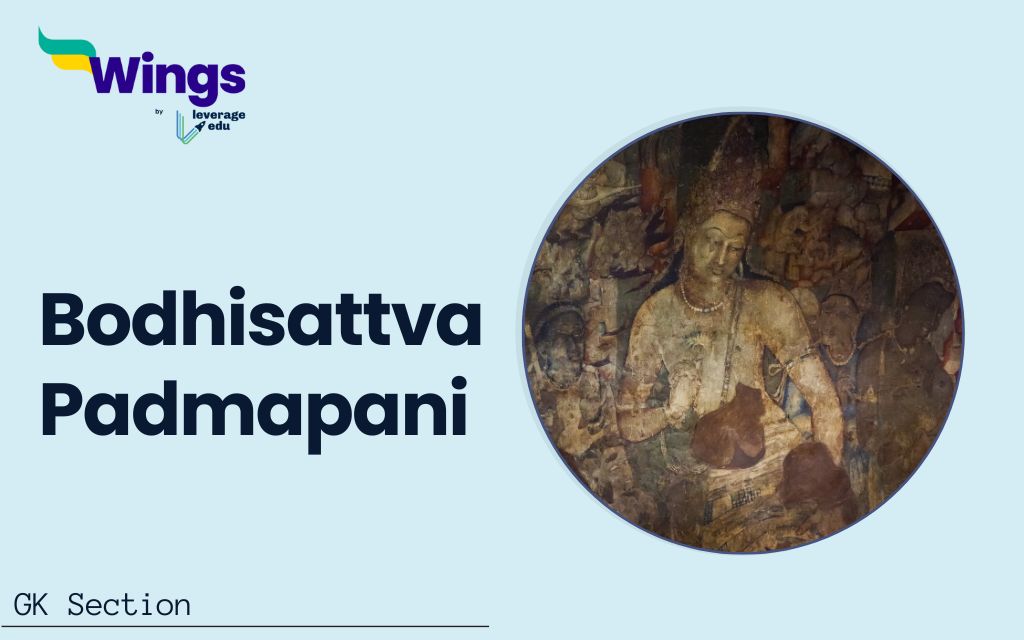Bodhisattva Padmapani is a mural painting believed to date back to the late 5th century. It is an artwork from the Ajanta Caves that most people are unaware of. It is a classical representation of arts during the Gupta Dynasty. The Ajanta caves were carved out of the rock cliffs and were designed to spread Buddhism. In this section, we will cover the art of Bodhisattva Padmapani and will provide an overview of this. This will help you to learn more about the art and cultural elements as It is an important part of the syllabus for students preparing for civil examinations such as the UPSC.
Contents
About Bodhisattva Padmapani
Bodhisattva Padmapani is a figure in Mahayana Buddhism who represents the qualities of compassion and mercy. The word “Padmapani” means “lotus holder,” which represents purity and spiritual enlightenment. This bodhisattva is often associated with Avalokiteshvara, who is considered the Bodhisattva of Compassion and is considered sacred across various Buddhist traditions.
Bodhisattva Padmapani : Symbolism
Padmapani is often seen in Buddhist art holding a blue lotus in the left hand and the right hand reflecting a kind gesture.
- The blue lotus symbolises purity and spiritual enlightenment.
- The right hand is in the varada mudra, which represents a promise to help all beings.
- Padmapani is shown with several arms and heads, representing the ability to meet the needs of all living beings.
- A form with a thousand arms is known as Sahasrabhujalokeshvara, and it has eyes on each hand. It symbolises the union of wisdom and compassion.
- Padmapani is known as Chenrezig in Tibet, where he is considered as their deity.
- The Dalai Lamas are believed to be incarnations of Chenrezig.
- In China, Padmapani is frequently associated with the feminine Bodhisattva Guanyin.
Also Read: Vajrapani: Origin, Representation, Literature and Art
Bodhisattva Padmapani :Historical Background
The concept of Padmapani originated in India during the first century CE.
- Padmapani is first mentioned in the Lotus Sutra, where he is shown as a kind saviour.
- As a bodhisattva, Padmapani has the ability to use one’s own enlightenment to help others achieve nirvana.
- This selfless act is important to the bodhisattva path, which promotes freedom from all suffering for all living beings.
- Padmapani is also related to numerous mantras that are believed to evoke the blessings of Avalokiteshvara.
- The most popular mantra is “Om Mani Padme Hum,” which means “Hail to the Jewel in the Lotus.” Devotees chant these mantras to seek the Lord’s guidance and blessings.
Bodhisattva Padmapani :Cultural Influence
Padmapani Avalokiteshvara has been an important subject in Buddhist art, especially throughout the Gandhara and Gupta periods.
- The Ajanta Caves in Maharashtra include some of the most beautiful paintings of Padmapani, who is portrayed with peaceful looks of divinity.
- In Nepal, the Newar people have made detailed paintings and sculptures of Padmapani. It combines Buddhist iconography to reflect local artistic patterns.
- These artworks are frequently shown in detailed and brilliant colours, highlighting the bodhisattva’s cultural significance.
- Padmapani’s influence extends beyond religious art, focussing on literature and popular culture.
- Padmapani’s loving attitude is highlighted in several Buddhist texts, including the Karandavyuha Sutra.
- Padmapani Avalokiteshvara continues to inspire people today in a variety of ways, including literature, film, and art.
- His image is used in meditation and rituals as a symbol of compassion.
Also Read: Mahayana and Hinayana Buddhism
Bodhisattva Padmapani: Ritualistic Practice
Padmapani Avalokiteshvara is the founder of a spiritual path dedicated to enlightenment and freedom for all living creatures.Devotees engage in various activities to receive Padmapani Avalokiteshvara’s blessings.
- Meditation and chanting mantras are common activities for developing compassion for others.
- In Buddhist-majority areas, Padmapani Avalokiteshvara is celebrated with numerous ceremonies and festivals.
- In Tibet, the Great Prayer Festival is an important celebration of Avalokiteshvara. During this event, monks come together to chant prayers and perform rituals for the betterment of all beings.
Related Posts
| Sarnath Lion Capital & Great Stupa of Sanchi | Sects of Buddhism: History, Origin, Branches |
| Yoga – Principles, History, Importance | Who Is The Dalai Lama? |
| Buddhist Councils: History, List and Teachings | Buddhist Education System: Features, Role & Merits |
| History of Indian Art; Origins, Milestones | Buddhism Philosophy and Concepts |
FAQs
Bodhisattva Padmapani is a mural painting believed to date back to the late 5th century. It is an artwork from the Ajanta Caves that most people are unaware of. Bodhisattva Padmapani is a figure in Mahayana Buddhism who represents the qualities of compassion and mercy.
Bodhisattva Padmapani is a famous mural painting from the Ajanta Caves. It is an ancient painting from the time when Buddhism was considered at its peak. It is recognised as a World Heritage Site.
Bodhisattva is a key concept of Buddhism. The word is made up of Sanskrit roots in which ‘Bodhi’ means ‘enlightenment’ and ‘Sattva’ means ‘being’. The overall meaning of this word is a being who is enlightened or on the way of enlightenment.
This was all about the “Bodhisattva Padmapani”. For more such informative blogs, check out our UPSC Exams Section and Study Material Section, or you can learn more about us by visiting our Indian exams page
 One app for all your study abroad needs
One app for all your study abroad needs














